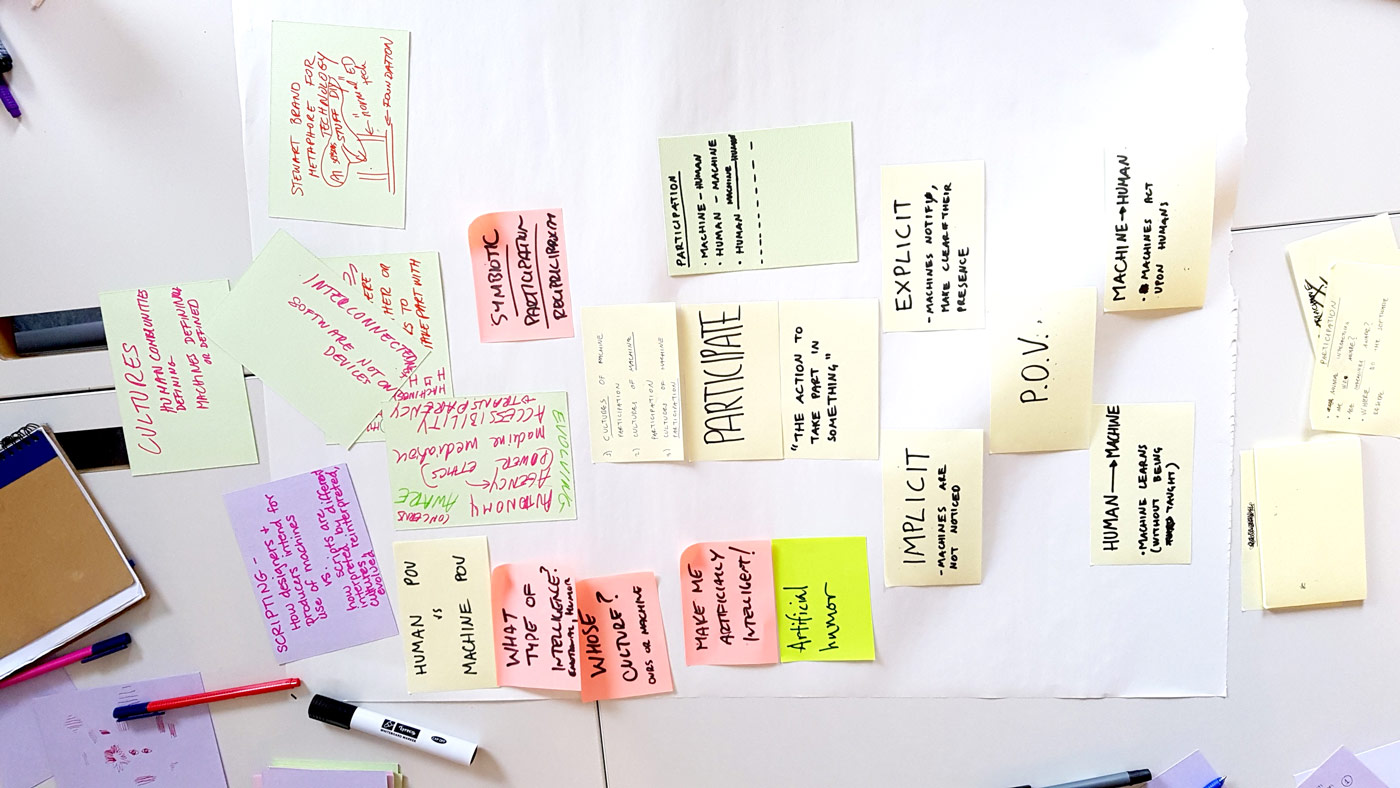Design Briefs – Spying on Loved Ones & Tangible Designs for Effort, Exertion, and Exhaustion
For this year’s Advanced Project Course in Interaction Design at KTH, I’m fortunate and excited to have two groups of second-year master’s students working with me on two project briefs – Spying on Loved Ones and Tangible Designs for Effort, Exertion, and Exhaustion during Outdoor Experiences. Excited to see their resulting design work in December!
Spying on Loved Ones
To spy on someone is commonly thought of as a negative or harmful act during which one person secretly observes or collects information on another for malicious purposes. Yet, we also “spy” for many positive reasons. For example, these might include watching a sleeping child through a baby monitor, checking a partner’s calendar to plan a surprise birthday party, or browsing the fridge of an elderly parent to ensure a healthy diet is being consumed. What these examples have in common is that they are acts of care. This projects investigates how we care for others through technology, both with technologies explicitly designed to survey or observe others and through technologies designed for other purposes yet leak implicit information that enables spying. Within this investigation, various forms of spying will be classified and critiqued, the social and cultural implications of these positive intentions with be explored, and speculative prototypes will be designed to either further enable or inhibit spying.
The project will follow the suggested steps: (1) a review and critique of technologies explicitly designed for spying in private and public spaces, (2) investigation into ways in which people spy on others through technologies not designed for spying, possibly through workshops, interviews, or cultural probes, (3) the design of speculative prototypes to either further enable or inhibit spying, resulting in an ecology of physical artifacts. Required skills include strong design sensibilities and an interest in critical design and design fiction.
This project builds upon Leaky Objects: Implicit Information, Unintentional Communication.
Tangible Designs for Effort, Exertion, and Exhaustion during Outdoor Experiences
Multi-day outdoor activities such as hiking, skiing, cycling, and horseback riding involve full body engagement, during which bodies become sore and often endure physical transformations. Yet despite perceived discomfort and difficulties, outdoors experiences are often considered rewarding and relaxing. Thus, rather than designing to make these activities easier or more comfortable, this project investigates designing tangible artifacts and devices to celebrate or enhance these experiences of effort, exertion, and exhaustion. This project is part of a broader, ongoing outdoors project within the Smart Implicit Interaction project, and has the opportunity to build upon recent interviews with participants who have engaged in long-term outdoors experiences.
The outcome of the project is open-ended, but students are expected to engage in a design process to that result in novel artifacts that are either proposed objects of use (e.g. products) or result in interesting new learnings (e.g. cultural probes). Students should have a design background or be interested in following a design process.
NordiCHI 2018 – Presentation & Slides
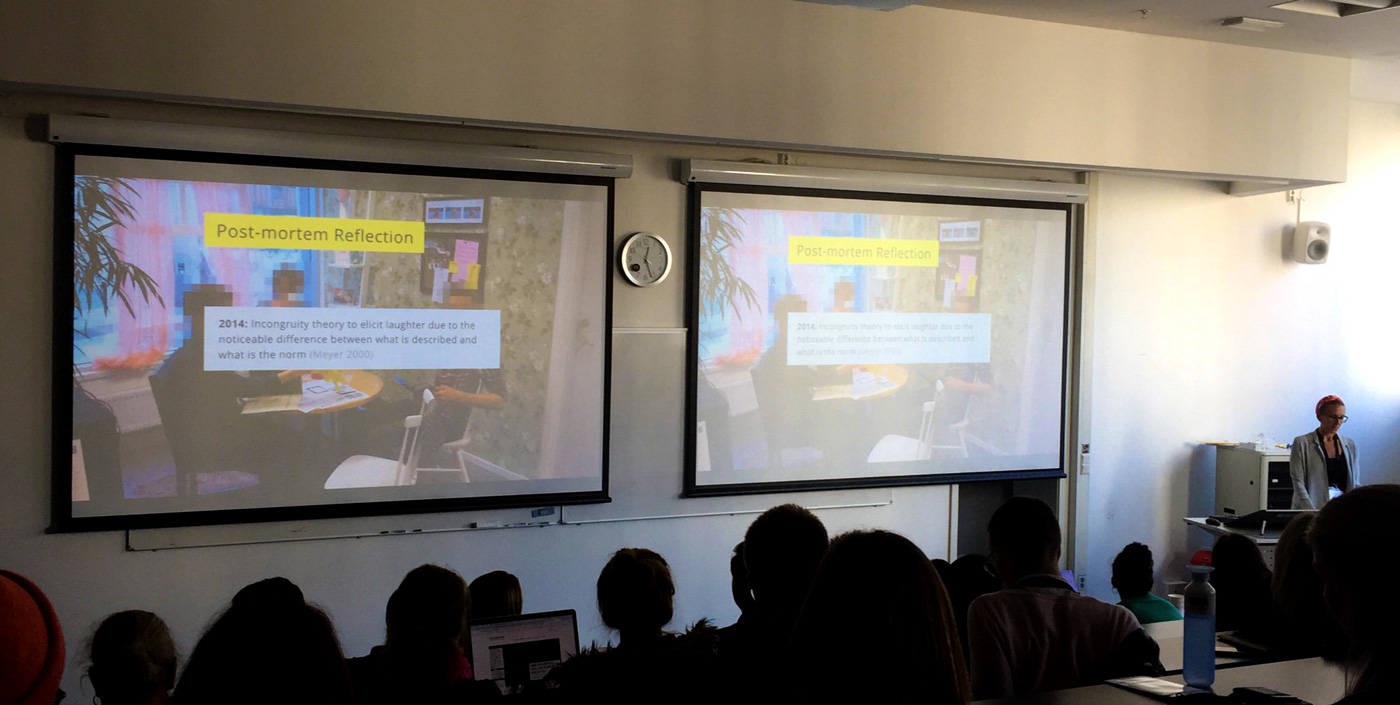
Early this week I presented a paper written with my PhD supervisor Ylva Fernaeus on the use of Humor in Design Fiction to Suspend Disbelief and Belief at NordiCHI 2018 in Oslo. This paper was part of the future scenarios track at NordiCHI, an excellent initiative and venue that explores the design of design fictions. Our paper contributed (1) a way in which humor might be used in design fiction (and design more broadly), (2) a design process that includes fieldwork to inform the design of design fictions, (3) and a human-scale design fiction as a method of communication and dissemination. For the presentation, I originally intended to role-play the paper presentation as a character from the fictional world, as I did when presenting the same project four years ago in Umeå as my master’s thesis, but last minute opted to not because of the opening introductions by moderators. Instead, I opened the presentation by jumping into the fiction with no context, and then gradually introduced more information and built reflections throughout the remaining of the presentation. I think this structure worked very well. The full paper is available here and the presentation below.
NordiCHI 2018 – Accepted Paper (Future Scenarios)
Very excited to have a NordiCHI 2018 paper accepted in the future scenarios track! Written with Ylva Fernaues, my supervisor at KTH, the paper is about why and how I used humor in my MFA thesis at Umeå Institute of Design four years ago.
Karey Helms, Ylva Fernaeus. 2018. Humor in Design Fiction to Suspend Disbelief and Belief. ACM Nordic Conference on Human-Computer Interaction (NordiCHI 2018), Oslo, Norway.
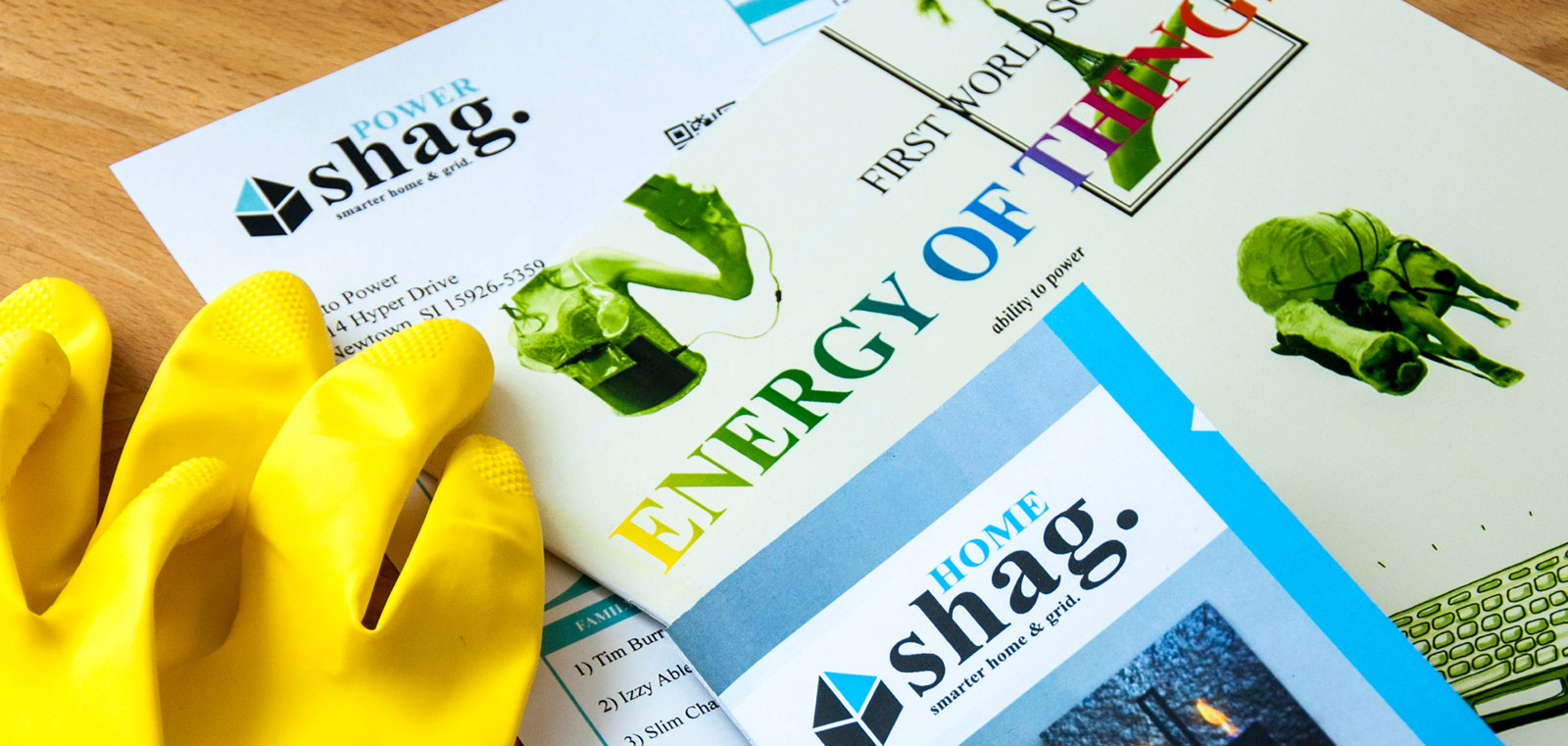
Humor in Design Fiction to Suspend Disbelief and Belief
This paper investigates humor as a resource and strategy for design with discourse as an intended outcome. While humor can incite empathy and understanding, it can also lead to alienation and disengagement. Through the detailing of the pre-narrative and narrative processes of an exemplar design fiction we describe why and how elements of humor, in particular puns, parody, and pastiche, were employed. Following the presentation of the fiction and its use in the design of an exhibition and diegetic prototypes, the paper presents responses from participants and audience members to reflect upon how humor was received within the design fiction. Following these reflections, as the near-future scenario was written four years prior to this paper and is now situated within present-day, it then concludes with a post-mortem reflection on the floating nature of humor.
UBISS 2018 – Humanistic HCI
Two weeks ago I spent a week in northern Finland at Oulu University for a workshop (UBISS summer school) on Humanistic HCI, lead by Jeffrey and Shaowen Bardzell from Indiana University. The workshop was structure around a curated reading list that included a book on Humanistic HCI, and covered aesthetic experiences, emancipatory approaches, and critical-interpretative methodologies applied towards HCI. In addition to reading seminars, we also carried out small group projects during which we applied humanistic epistemologies to shared research domains. It was an incredible (and exhausting!) experience, both this particular workshop I participated in and the summer school as a whole!
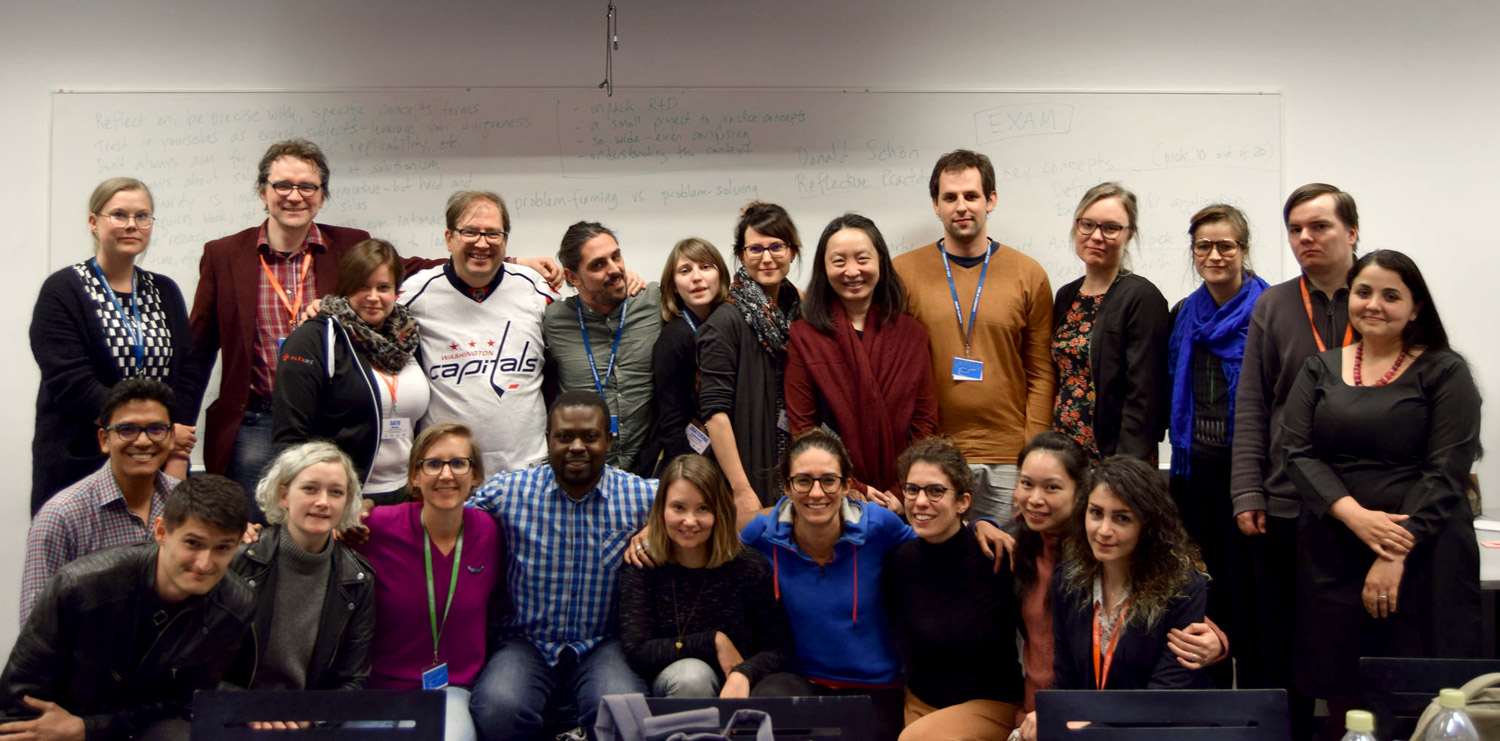
Advanced Project Course in Interaction Design at KTH
Loved being a part of the Advanced Project Course in Interaction Design with Jarmo, a colleague at KTH! In this new course that took place this past fall (2017), students carried out a small research project in close collaboration with KTH researchers. In addition to assisting with course admin and examination, I also supervised a group of three students working on a pee-ometer – a device that predicts when someone has to pee – for my research on implicit interactions and machine learning as a design material. Looking forward to running the course again this coming fall!
AAAI 2018 – Presentation & Slides
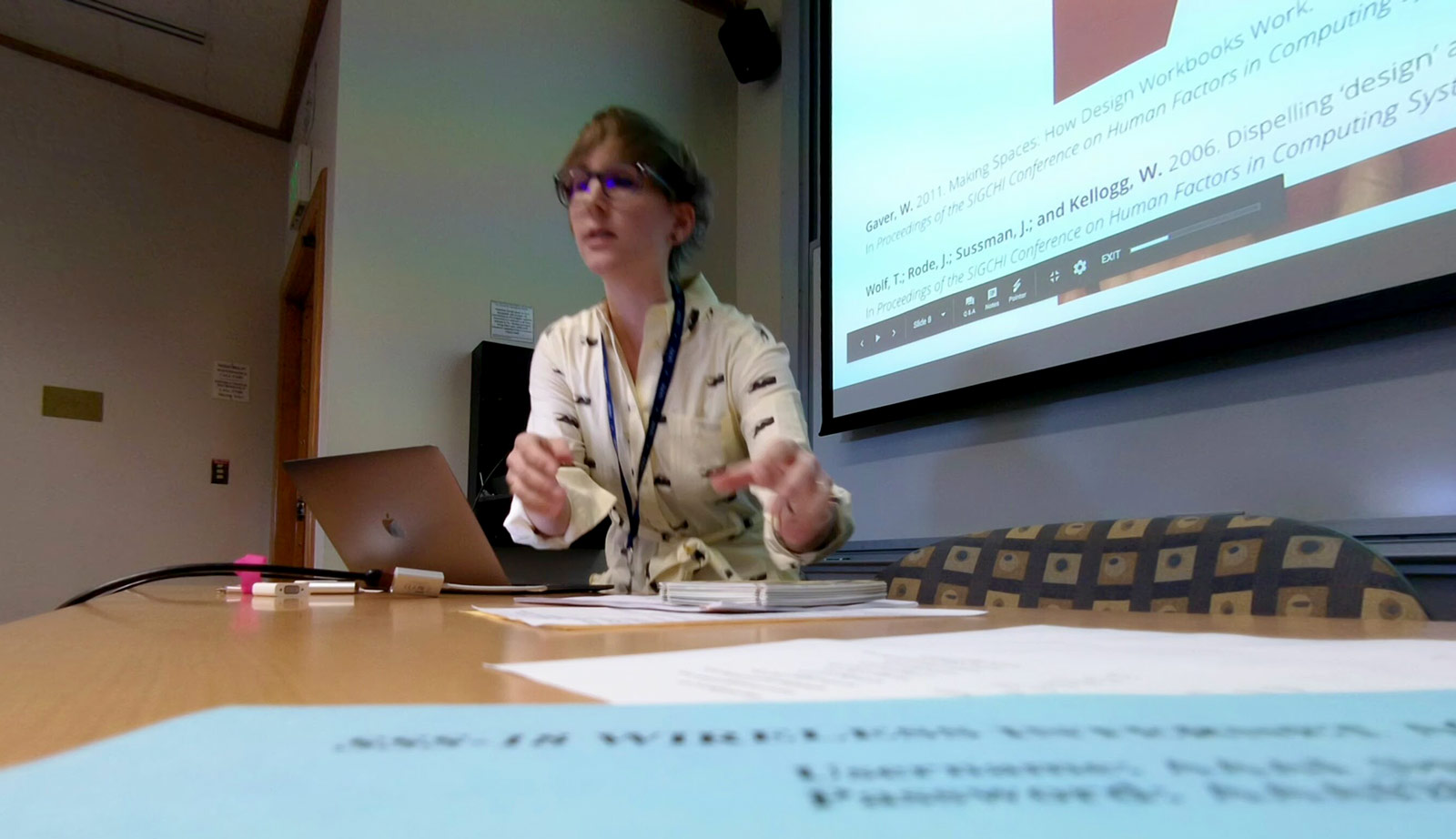
Last week I presented my paper Design Methods to Investigate User Experiences of Artificial Intelligence at the 2018 AAAI Spring Symposium on the User Experiences of Artificial Intelligence. The picture above was taken by a Google Clips camera, which was also one of the presented papers. Below are my slides, which contain supplementary images to my paper on the three design methods I have engaged with relative to the UX of AI. Another blog post will soon follow with reflections on other papers presented.
CHI 2018 – Attending Workshop on HCI Outdoors
This year I’ll be going to CHI 2018 as a student volunteer and to attend the workshop HCI Outdoors: Understanding Human-Computer Interaction in the Outdoors. Very much looking forward to connecting with the HCI outdoors community for a new research project!

A Walk in the Woods: Gear and Infrastructure in the Outdoors (position paper PDF)
In this position paper, we describe an initial research activity, a short walk in the woods, to position our interest in HCI and the outdoors. We present three preliminary reflections from our hike on relationships with gear and infrastructure that enable meaningful outdoor experiences. These include parallels between packing gear and preparing devices, contrasting notions within bodily comfort and brand allegiance, and safety bubbles enabled by actual or expected infrastructures.
AAAI 2018 – Accepted Spring Symposia Papers
Two papers were accepted to the AAAI 2018 Spring Symposia: Design Methods to Investigate User Experiences of Artificial Intelligence for The UX of AI symposium and The Smart Data Layer for Artificial Intelligence for the Internet of Everything symposium. I’ll be presenting the former at Stanford at the end of March, bellow is the abstract.

Design Methods to Investigate User Experiences of Artificial Intelligence
This paper engages with the challenges of designing ‘implicit interaction’, systems (or system features) in which actions are not actively guided or chosen by users but instead come from inference driven system activity. We discuss the difficulty of designing for such systems and outline three Research through Design approaches we have engaged with – first, creating a design workbook for implicit interaction, second, a workshop on designing with data that subverted the usual relationship with data, and lastly, an exploration of how a computer science notion, ‘leaky abstraction’, could be in turn misinterpreted to imagine new system uses and activities. Together these design activities outline some inventive new ways of designing User Experiences of Artificial Intelligence.
PhD’ing – Writers’ Retreat, Project Offsite, Outdoors Research, and Making Preciousness
Today I saw a meme on Instagram which said, “We are now entering the third month of January.” I couldn’t relate more! And looking back over the past few weeks, cannot believe all that has already happened in 2018.
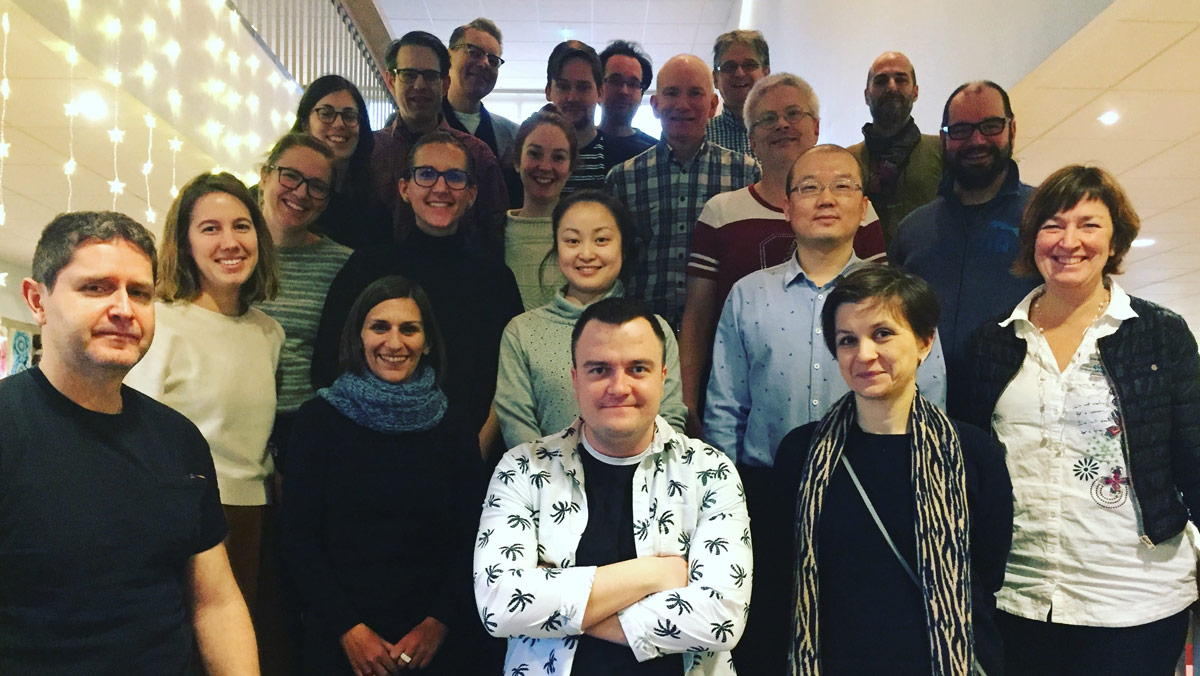
Writer’s Retreat
Following a paper deadline in early January, my department at KTH (Media Technology and Interaction Design) kicked off 2018 with a writers’ retreat. What happens at a writers’ retreat? We book a venue in the Stockholm archipelago for three days and two nights, and write. And sauna and winter swim, but mainly write. The primary purpose of the retreat is to provide time and space away from everyday academic duties, from teaching to admin responsibilities, in order to focus on increasing the quality and quantity of our writing output. During the three days, we follow an agile framework in which junior/senior pairs write in ~45 minute sprints and then provide ~15 minutes of feedback. In addition to intense writing blocks, lunches, dinners, and evening activities provide ample opportunities to better know our colleagues professionally and personally. Though equally as exhausting as the writing, this social time I find incredibly valuable in creating a continued collaborative culture at work.
During this year’s writing camp I started a paper on a Pee-ometer, a recent project by Master’s students that I proposed and supervised in which they prototyped a wearable device that predicts when a user has to pee to investigate Machine Learning as a design material.
Project Offsite
In mid January, the Smart Implicit Interaction project had a two day project offsite. As the project is composed of differing philosophical and methodological backgrounds – i.e. Artificial Intelligence, Social Sciences, and Interaction Design – the first day consisted of a beginners overview into reinforcement and representational learning in neural networks to introduce technical terminology and objectives. During the second day, all of the sub-projects presented their current status and goals for the year. I specifically presented two ongoing design projects, data-driven design methods and the Pee-ometer. In the former, I discussed early design activities and resulting concepts from investigating the implications of screenshots as a data source. In the latter, I discussed three high-level interests guiding future project directions, including Machine Learning as a design material, interactional loops, and critique and ethics. Overall, it was inspiring to share and strategize better collaborations while revisiting overarching project objectives.
Project Offsite
Last week continued January’s streak of out-of-office research activities and into the forest. To kick off an new outdoors project, myself and three senior researchers went on a mid-week day hike 30 minutes outside of Stockholm. Not only was I surprised at a Professor’s ability to make a fire in the snow, but the excursion was both refreshing and constructive. More in the coming months!
Making Preciousness
And last but definitely not least, friend and fellow PhD student Vasiliki successfully defended her thesis Making Preciousness: Interaction Design Through Studio Crafts. Her opponent Ron Wakkary gave a much deserved brilliant presentation of her work before lengthy discussions with him and the committee. Admittedly, it is selfishly bittersweet to see her finishing as she has been a tremendous support and inspiration during the first year of my own PhD.
Books read in 2017
38. A Gentleman in Moscow. Amor Towles.
37. The Destructives. Matthew De Abaitua.
36. Higher education meets private use of social media technologies: An explorative study of students’ use. Pernilla Josefsson (thesis).
35. Bowling Alone: The Collapse and Revival of American Community. Robert D. Putnam.
34. Geography of Home: Writings on Where We Live. Akiko Busch.
33. The Stuff of Bits: An Essay on the Materialities of Information. Paul Dourish.
32. Art as Experience. John Dewey.
31. Things That Keep Us Busy: The Elements of Interaction. Lars-Erik Janlert & Erik Stolterman.
30. The Alice Network: A Novel. Kate Quinn.
29. Before We Were Yours. Lisa Wingate.
28. About Face 3. Alan Cooper.
27. Our Robots, Ourselves: Robotics and the Myths of Autonomy. David A. Mindell.
26. Norse Mythology. Neil Gaiman.
25. Mating in Captivity: Reconciling the Erotic & the Domestic. Esther Perel.
24. Wanderlust: A History of Walking. Rebecca Solnit.
23. Studying Those who Study Us: An Anthropologist in the World of Artificial Intelligence. Diana E. Forsythe.
22. The Handmaid’s Tale. Margaret Atwood.
21. Bonk: The Curious Coupling of Science and Sex. Mary Roach.
20. A Man Called Ove. Fredrik Backman.
19. The Circle. Dave Eggers.
18. Problems of Knowledge: A Critical Introduction to Epistemology. Michael Williams.
17. Alone Together. Sherry Turkle.
16. Closer: Performance, Technologies, Phenomenology. Susan Kozel.
15. Thinking Machines: The Quest for Artificial Intelligence – and Where It’s Taking Us Next. Luke Dormehl.
14. Sapiens: A Brief History of Humankind. Yuval Noah Harari.
13. The Design of Implicit Interactions. Wendy Ju (thesis).
12. Design Research Through Practice: From the Lab, Field, and Showroom. Ilpo Kalevi Koskinen, Johan Redstrom, John Zimmerman, Stephan Wensveen, and Thomas Binder.
11. The Goldfinch. Donna Tartt.
10. Telling About Society. Howard Becker.
9. Thinking, Fast and Slow. Daniel Kahneman.
8. Technology and the Character of Contemporary Life: A Philosophical Inquiry. Albert Borgmann.
7. Who Moved My Cheese?. Spencer Johnson.
6. The Reflective Practitioner: How Professionals Think in Action. Donald Schön.
5. Of Mice and Men. John Steinbeck.
4. Daily Rituals: How Artists Work. Mason Currey.
3. Sciences of the Artificial. Herbert A. Simon.
2. Designing for Interaction: Creating Innovative Applications and Devices. Dan Saffer.
1. Obfuscation. Finn Brunton and Helen Nissenbaum.
TEI 2018 – Studio Call for Participation
Sociomateriality: Infrastructuring and Appropriation of Artifacts
Novel materials and innovative applications can sometimes outweigh a reflective perspective on the roles that objects and materials can play in social life. In this Studio, we want to bring together researchers and practitioners who are interested in exploring design outcomes from a sociomaterial perspective. By having prototypes at the center of the Studio activities, we intend to create prompted speculative fictions that link the material outcomes of design practice to social agency and cultural effects.
This studio will offer an opportunity to examine how objects might participate in social spheres as well as act as material bridges to their design process. We will do this through both hands-on examination of design objects, and inquiry into the infrastructuring and appropriation of these artifacts. The themes that will be examined are agency, material participation, and cultural performance of things. We encourage participants to bring their own prototypes.
We invite scholars and design practitioners from a variety of fields to register on the TEI 2018 website. For any questions, email the workshop organizers at mailto:hello@sociomaterial-things.com.
For any questions, email the workshop organizers at:
mailto:hello@sociomaterial-things.com.
More information you can find at the Studio webpage:
http://sociomaterial-things.com
Organizers
Tom Jenkins – Georgia Institute of Technology
Vasiliki Tsaknaki – KTH Royal Institute of Technology
Karey Helms – KTH Royal Institute of Technology
Ludvig Elblaus – KTH Royal Institute of Technology
Nicolai Brodersen Hansen – TU Eindhoven
PhD’ing – Taboo, Tinkle, Algorithms, and Home
For an autobiographical project building off Leaky Objects, in which I’m allowing myself to undertake a significantly slow design process, this week I read Geography of Home: Writings on Where We Live by Akiko Busch. The book is a collection of beautiful musings organized by room and touches upon notions of comfort, dichotomies between possessions and spaces, clutter, deeply personal rituals, thresholds, processions, and changing functionalities. So much I love in this book while mapping the geography of our tiny home which defies all traditional expectations and conditions. Last year before moving from London to Stockholm, we read The Life-Changing Magic of Tidying Up, an amusing read that we nevertheless abided by and asked everything we own, “Do you bring me joy?” Not only did we end up giving away bags of stuff, but it also prompted many meaningful discussions regarding and aligning views on possessions and a home, in addition to musings around if someday everything will be connected, will all our possessions? And why do we keep them, and do we deserve them if possession implies care, custody, and guardianship? More and more through many of my ongoing projects and initial concepts, I realize I’m interested in overlaps between privacy and care, and perhaps comfort too.
A project I recently started with MSc students is investigating predicting pee habits, which to many is a taboo topic due to the invasive nature of the proposed interaction and an aversion to recognizing private bodily functions. A subsequent discussion with my supervisor on researching taboo topics led to the reading of the paper Accountabilities of Presence: Reframing Location-Based Systems and the website Between the Bars: Human Stories from Prison. In the paper, the authors research paroled sex offenders who are tracked via GPS to explore the intersection between mobility, presence, and privacy; while the website offers a digital platform to share handwritten content from people in prison who do not have access to internet. In both cases, what could be considered extreme or fringe users are researched or designed for, and equally interesting for different reasons, they also serve as interesting case studies that either directly learn from or address the messy realities of society. One of my biggest peeves – designers don’t address the messiness of life nearly enough. So while pee might not be prison, it is definitely an everyday and occasionally very messy, mundane, and universal reality that should not be ignored as I believe there is much to be gained from deviating from designing only delightful experiences.
On a fun, related note, I recently found out that Engelbart conceived what he called the “tinkle toy”, a small waterwheel in a toilet bowl that would spin when pee was run over it, serving as a potty-training aid for boys as the interaction was designed to be an incentive to pee in the toilet. From Markoff’s What the Dormouse Said: How the Sixties Counterculture Shaped the Personal Computer Industry.
A week or two ago, it was difficult to miss Algorithms as culture: Some tactics for the ethnography of algorithmic systems on Twitter. Found it incredibly informative and a nice compliment to Dourish’s The Stuff of Bits: An Essay on the Materialities of Information, which I started last week for implicit interaction book club. The paper also led me to these slides The algorithm multiple, the algorithm material: Reconstructing Creative Practice – in which I was thrilled to see my former UVa architecture professor and brief employer Jason Johnson of Future Cities Lab mentioned.
Lastly, this morning I found this open source software by Rebecca Fiebrink for real-time, interactive Machine Learning that hopefully I can use with Arduino.
PhD’ing – Wonder, Autonomy, Frameworks, and Infrastructures
Trying something new with the aim of semi-regular updates regarding what I’m reading, working on, and thinking about.
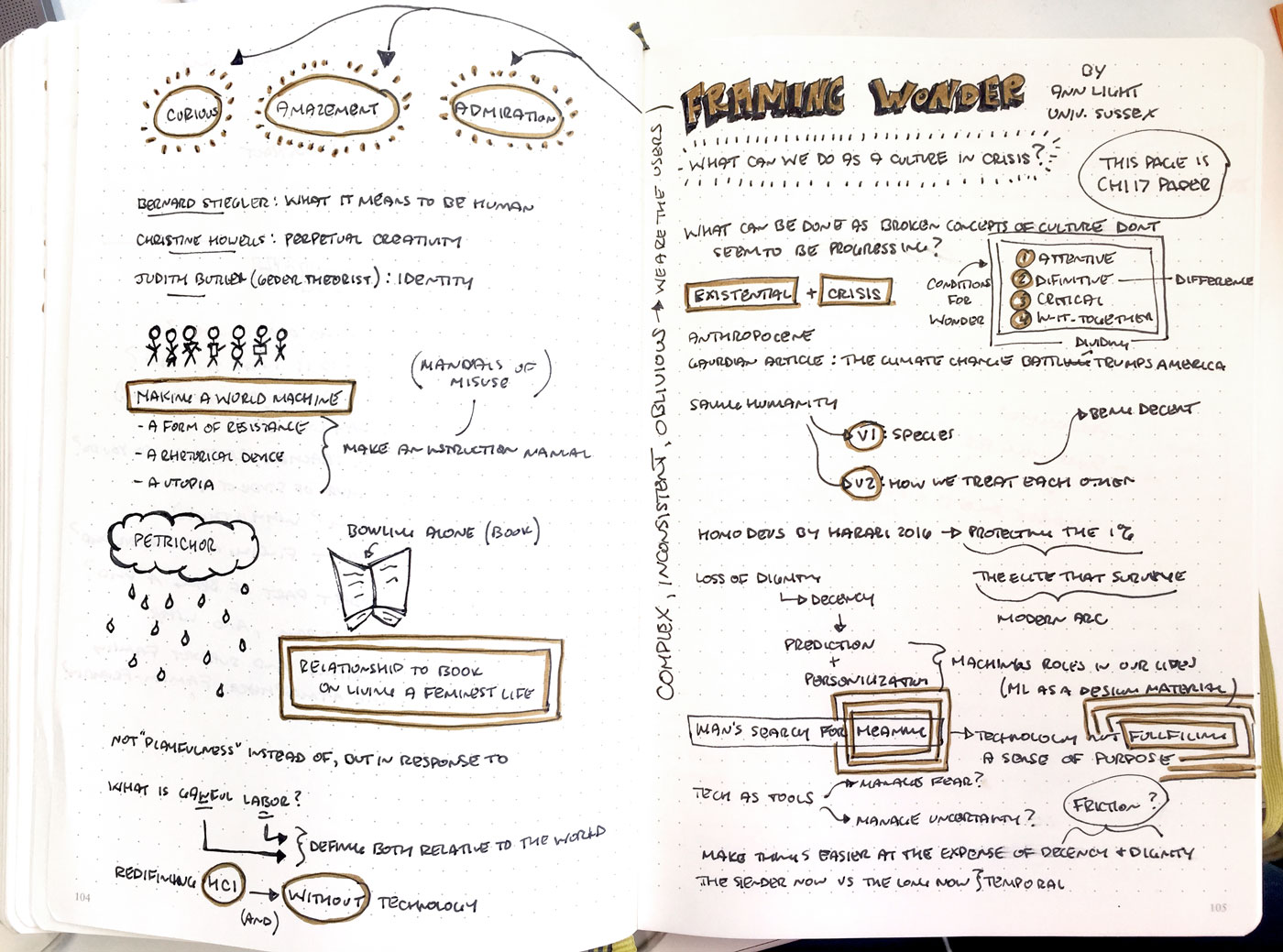
Last week had a short chat with Ann Light from the University of Sussex regarding my work and attended her guest lecture Framing Wonder: Beyond Design for Existential Crisis (sketch notes above). Dark yet very inspiring talk and highly recommend her related paper Design for Existential Crisis from CHI17. Both the talk and her paper inspired me to look into care ethics and feminist theory regarding my work.
For a recent paper and my ongoing multi-disciplinary project work, have been thinking a lot about Terry Winograd’s Shifting viewpoints: Artificial intelligence and human–computer interaction, in particular how to work across philosophical and methodological differences.
Based on a colleague recommendation, recently listened to Our Robots, Ourselves: Robotics and the Myths of Autonomy by David Mindell, a very accessible contribution to discourse on the meaning of autonomy. Throughout the book, within each of many case studies, he repeatedly challenges listeners (readers) to ask, ‘Where are the people, which people are they, what are they doing, and when are they doing it?” as he proposes an emphasis on human-computer relationships rather than the idea or potential of replacement. My favorite of his examples regards remote control of Mars rovers from Earth bound operators and the coinciding debate if presence can be felt at such a distance and with significant time delays – is remote presence real presence?
Last week discussed Things That Keep Us Busy: The Elements of Interaction by Lars-Erik Janlert and Erik Stolterman in a research book club with a focus on Implicit Interaction. I found the book an easy read as it was very much like a collection of papers (which most of it draws from). While I appreciated the provision of definitions, frameworks and objective perspective – as in taking the object’s instead of the user’s perspective – overall there was much I disagreed with, in particular the notion that implicit interaction decreases interactivity, and found it difficult to maintain a narrow perspective that doesn’t regard the social or systemic implications. Perhaps also, it seemed to contrast philosophically with Dewey’s Art of Experience which I am reading for a PhD course on the theoretical foundations of UX, and as a design researcher situated in a technical university am over-resisting the application of frameworks upon a field dependent on embracing the subject, chaotic, and messy nature of the world.
Attended a great talk by my friend Lorenzo at IxDA Stockholm’s event Questions and answers in the design process with Nordic Morning. Great nuggets regarding the materialization of cultures to engage people in discourse and materialization of infrastructures to enable designers to transform them. Definitely calls for a revisit of his paper Materializing infrastructures for participatory hacking.
Lastly, in addition to a bunch of course grading, this week I’ll be continuing concepts derived from a recent project workshop on designing with data and starting a new project with three KTH master’s student on prototypes to probe the notion of training when approaching Machine Learning as a design material. A related paper includes UX Design Innovation: Challenges for Working with Machine Learning as a Design Material.
EuroIA 2017 – Smart Implicit Interactions
Two weeks ago I had a lovely time speaking about my current research interests and questions surrounding Smart Implicit Interactions with industry practitioners at EuroIA 2017 in Stockholm!
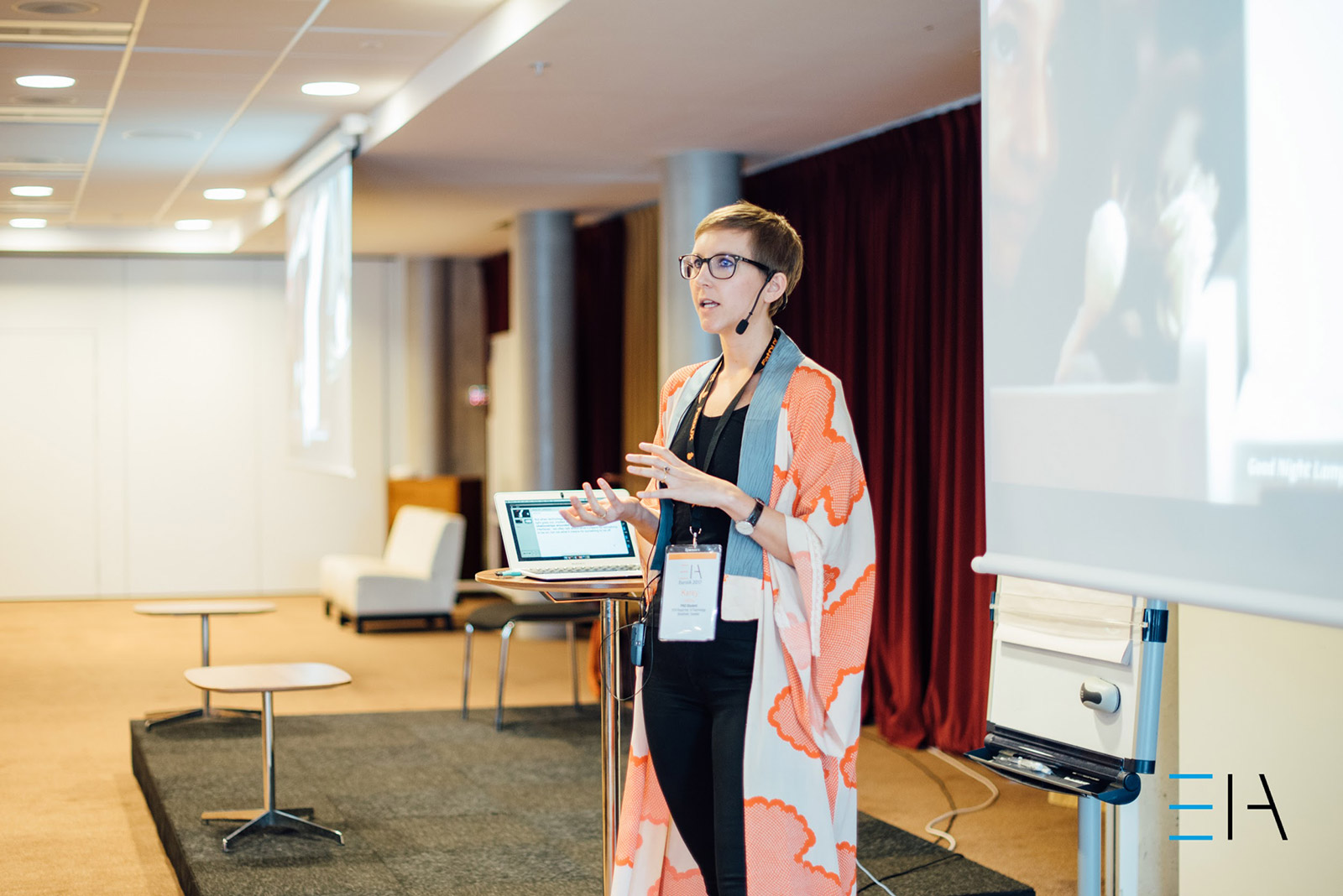
Thanks EuroIA for the INTENSE photo above and Inge Nahuis for the sketchnotes below!
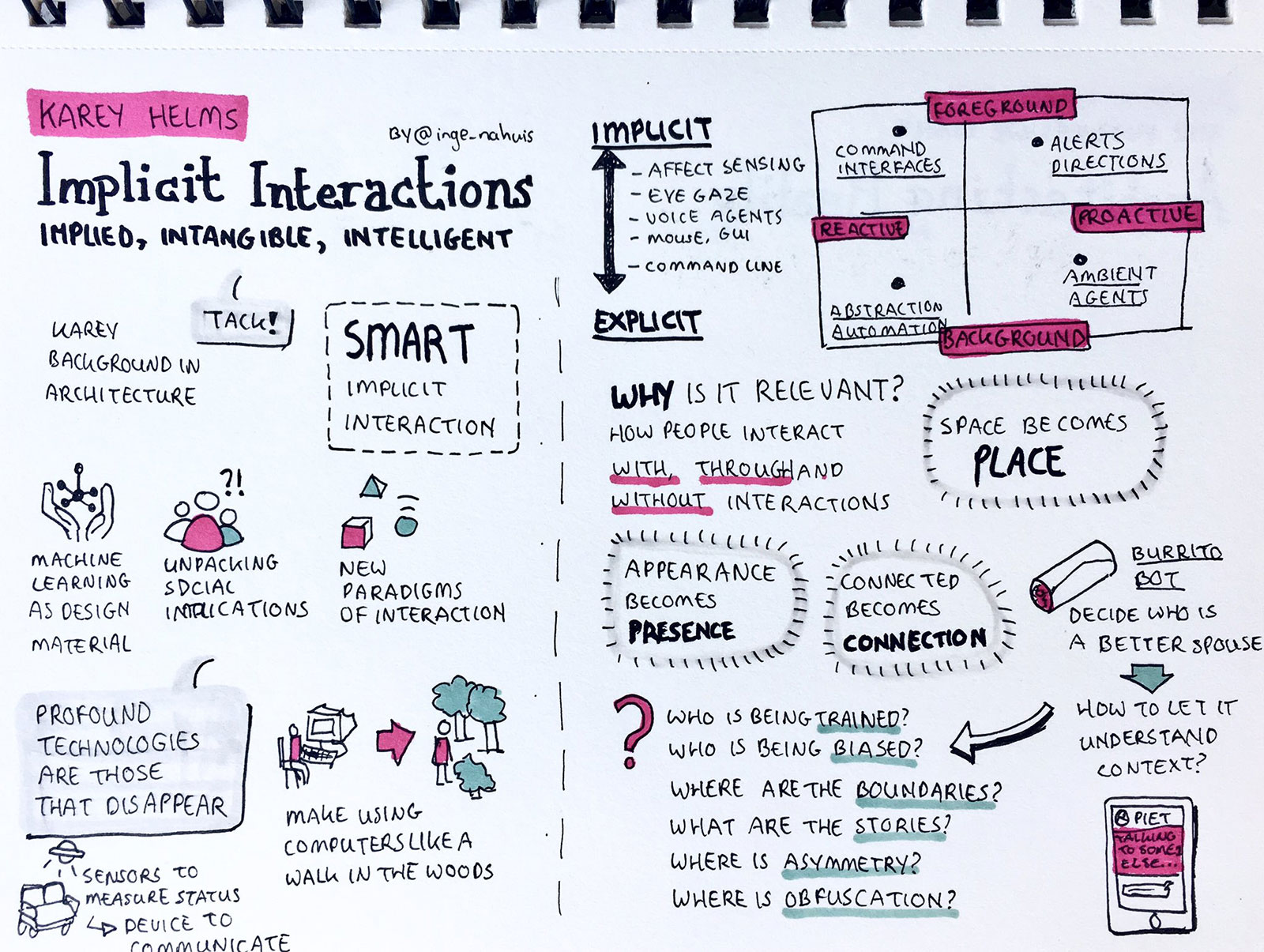
DIS 2017 – Workshop Reflections and Design Fiction
As previously mentioned, I attended, and thoroughly enjoyed, the workshop at DIS17 on People, Personal Data and the Built Environment. Not only was the topic relevant to my project, interests, and background, but I also found the strict structure (and quick introductions) very effective and thus resulting in meaningful discussions at the end of the day.
The below image is a fraction of a future IoT system followed by a corresponding fictional narrative created with Albrecht Kurze.

Unfinished Business
2022 – five years after 2017 – a public space odyssey
It is the year 2022, five years after the government started to implement the dynamic waiting management system in public buildings. To simultaneously reduce waiting times while keeping visitors preoccupied, the system routes visitors on an adaptive, and often the least efficient, way through the building. As this has unsurprisingly resulted in many lost visitors, a place-based location-aware voice-controlled guiding and help-and-get-helped system was introduced, in which visitors can leave voice messages to aid other lost visitors.
Dave was born in 1950 and retired in 2017, the same year his wife died. Every time he enters public buildings, he is asked to confirm the usage and data processing terms of the building, as smart building are being classified as interactive data processing units by the 2019 extended GDPR. These temporary consents are based on minimum viable data and are thus only valid for a single visit as all data collected is automatically deleted or anonymized upon leaving.
Dave pretends to apply for a hunting license but actually just wants to hear his wife’s voice in a message she left in the help-and-get-helped system after the system’s implementation. As the system is gender intelligent, he needs a female to find his wife’s message. Furthermore, the message is not locationally linked nor directly addressable because of dynamic shuffling and the anonymization policy.
Claire was born in 2001 and has been applying for a family planning permit for the past five days. As the system is implicitly regulating family planning, prioritizing lonely widows and widowers for which Claire is not, it sends her on an impossible route. As she is not successful in her quest for a permit by the end of each day, the temporary data consent causes her to restart the whole process the following day, resulting in a never ending journey.
But this one special day Dave and Claire met, two lost visitors, trapped some way in and by the system. They decided to help each other and resolve their unfinished business.
DIS 2017 – Poster Presentation of Leaky Objects
Last week at DIS 2017 in Edinburgh I presented a poster (pdf) for my work-in-progress Leaky Objects: Implicit Information, Unintentional Communication. Very thankful for the discussions and feedback!
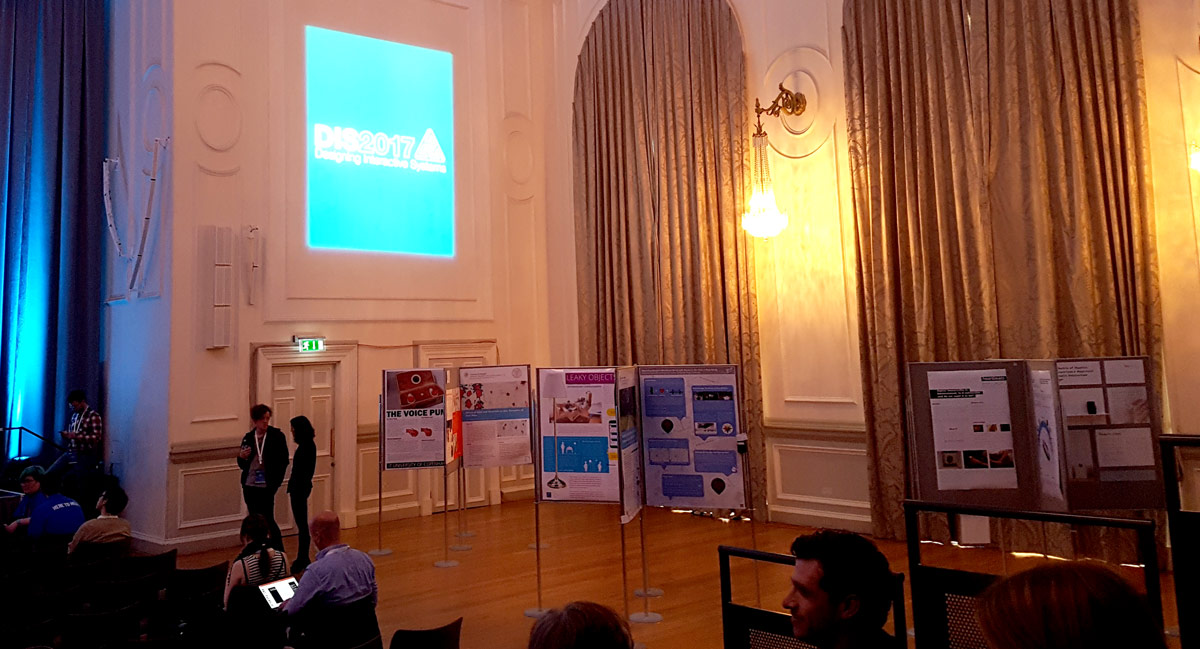
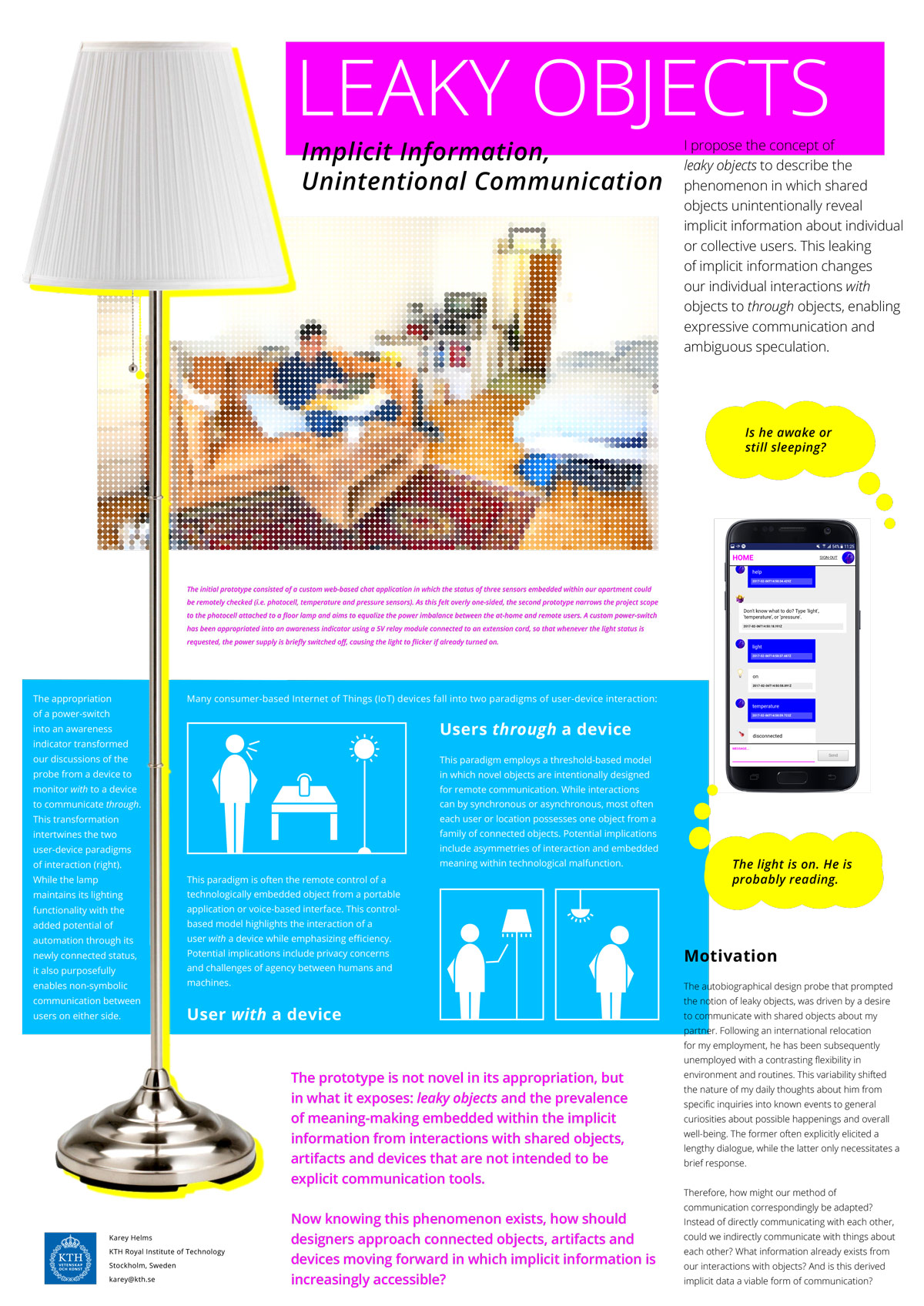
DIS 2017 – Workshop on People, Personal Data and the Built Environment
Yesterday I attended the workshop Workshop on People, Personal Data and the Built Environment at DIS 2017. Was incredibly inspiring and perhaps the best workshop format I’ve experienced as of yet! Below is my position paper.
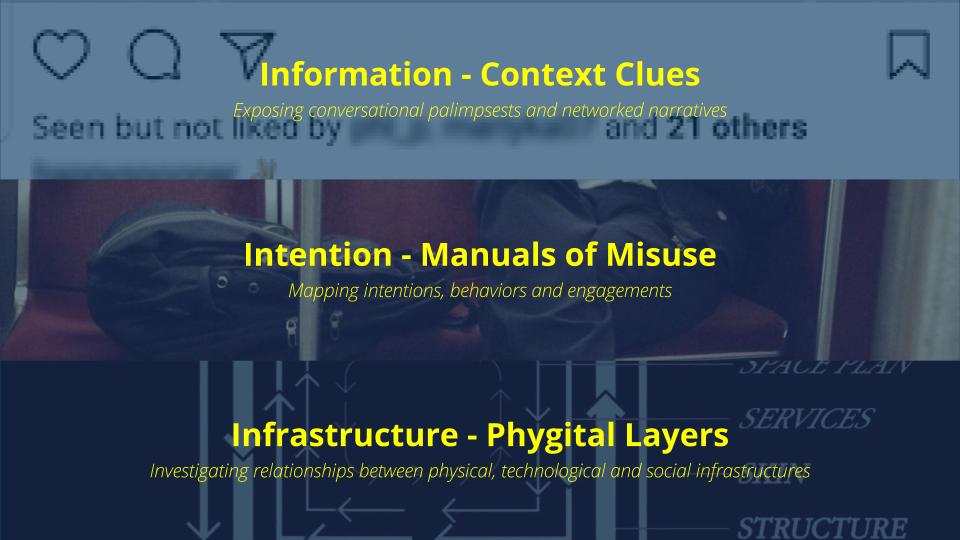
Implicit Interaction: Information, Intention and Infrastructure (position paper PDF)
In this position paper I present three in-progress design projects that are initial explorations into Smart Implicit Interaction, which is investigating data as a design material and a new paradigm of interaction for the Internet of Things. The first project, Context Clues, critically examines our existing interactions and exchange of implicit information across digital mediums. The second project, Manuals of Misuse, is an Internet of Things design brief in which students are exploring the peripheral intentions embedded within everyday objects to design novel connections while exposing hidden patterns of behavior and engagement. The third project, Phygital Layers, is an architectural study seeking to understand the implicit relationships between physical, technological and social infrastructures within domestic environments. While all three projects differ across scale and medium, they offer potential avenues of investigation into designing for people, data and the built environment.
EuroIA 2017 – Upcoming talk on Implicit Interactions
Very excited to be giving a 20 minute talk on September 30th at EuroIA in Stockholm on Implicit Interactions: Implied, Intangible and Intelligent! Below is my talk abstract.
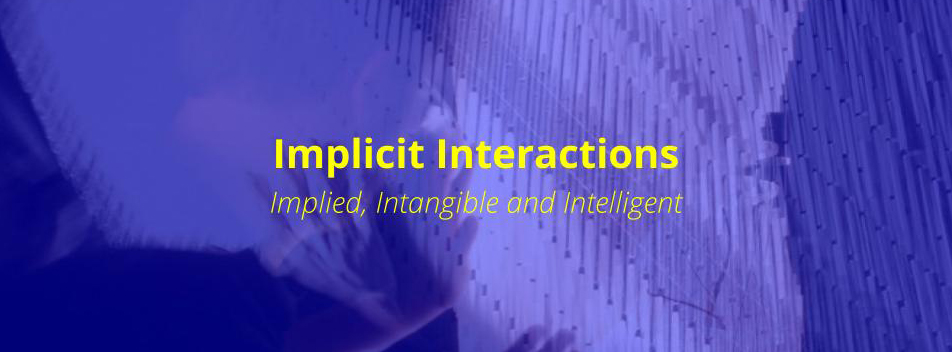
As our physical and digital environments are ubiquitously embedded with intelligence, our interactions with technology are becoming increasingly dynamic, contextual and intangible. This transformation more importantly signifies a shift from explicit to implicit interactions. Explicit interactions contain information that demands our attention for direct engagement or manipulation. For example, a physical door with a ‘push’ sign clearly describes the required action for a person to enter a space. In contrast, implicit interactions rely on peripheral information to seamlessly behave in the background. For example, a physical door with motion sensors that automatically opens as a person approaches, predicting intent and appropriately responding without explicit contact or communication.
As ambient agents, intelligent assistants and proactive bots drive this shift from explicit to implicit interactions in our information spaces, what are the implications for everyday user experiences? And how do we architect dynamic, personal information in shared, phygital environments?
This talk aims to answer the above questions by first introducing an overview of explicit and implicit interactions in our mundane physical and digital environments. Then we will examine case studies in which unintended and unwanted consequences occur, revealing complex design challenges. Finally, we will conclude with example projects that explore a choreography between explicit and implicit interactions, and the resulting insights into architecting implied, intangible and intelligent information.
DIS 2017 – Accepted Works-in-Progress (PWiP)
Both very unexpected and exciting to have a work-in-progress accepted to DIS 2017 in Edinburgh. I wrote about an ongoing autobiographical design project that was started this spring along side a few other explorations to kick-start my PhD at KTH this year. Very thankful to Kia Höök who talked me through my insight at a KTH Interaction Design writer’s camp in March and the reviewers who gave great feedback on how to continue developing it into a full paper.
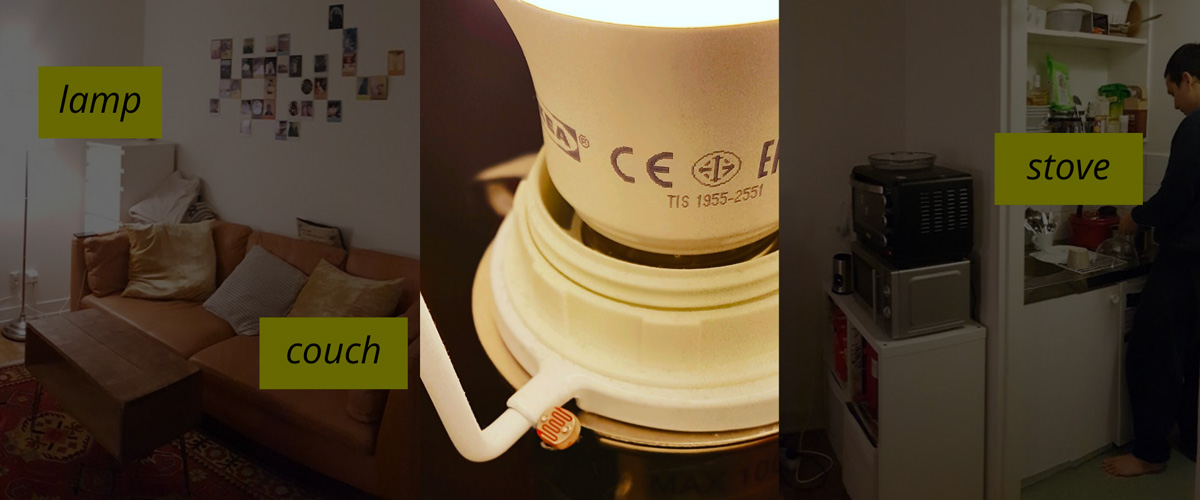
Leaky Objects: Implicit Information, Unintentional Communication (PDF)
This paper introduces the concept of leaky objects to describe this phenomenon in which shared objects unintentionally reveal implicit information about individual or collective users. This leaking of implicit information changes our individual interactions with objects to through objects, enabling expressive communication and ambiguous speculation. The aim of this paper is raise awareness of this phenomenon through an ongoing autobiographical design probe in which remote interpersonal communication through a connected object is being explored, and raise questions regarding the potential implications for designers.
Workshop – The Cultures of Machine Participation
Earlier this week I attended a workshop held by the research group for the design of information systems (DESIGN) at the University of Oslo (UiO) on The Cultures of Machine Participation.
